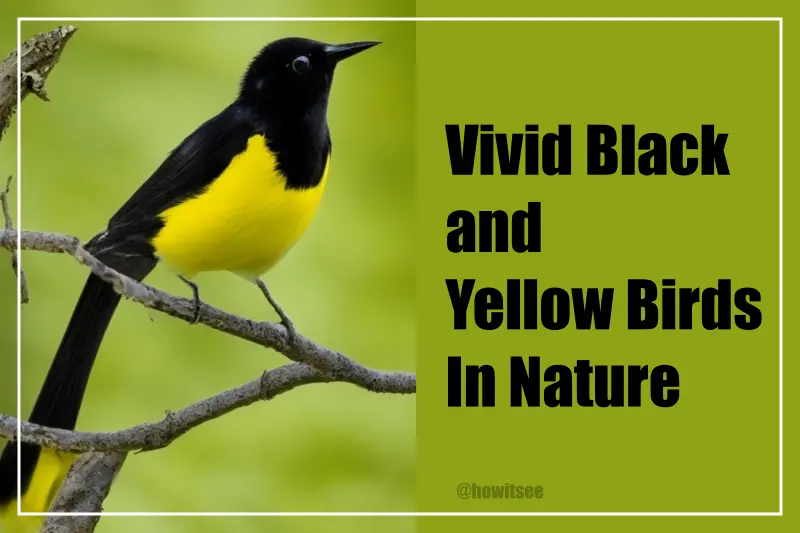Welcome to another journey through the avian world! In this article, we will explore the fascinating beauty of 25 black and yellow birds. These remarkable creatures showcase a mesmerizing combination of contrasting colors that captivate our attention and leave us in awe.
Each bird, from colorful songbirds to unique finches, has distinct patterns and behaviors that make it a true marvel of nature. So join us as we dive into the enchanting world of black and yellow birds, where elegance meets vibrancy, and beauty takes flight.
25 Vivid Black and Yellow Birds
1. Eastern Meadowlark
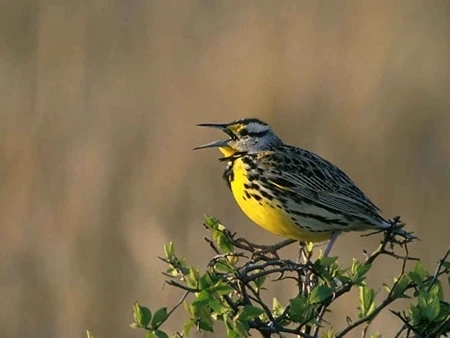
| Scientific Name | Sturnella magna |
| Size | 19-26 centimeters |
| Life Span | 5 years |
| Geographic Location | Eastern North America |
The Eastern Meadowlark is a charming and melodious bird that fills with its rich and melodious calls the grasslands and meadows.
One of the distinguishing features of the Eastern Meadowlark is its vibrant yellow chest and underparts and black and brown upperparts, adorned with intricate black streaks and markings.
The male Eastern Meadowlark also has a striking black “V” curve on its breast, which elevates its look even more.
2. Yellow Headed Blackbird
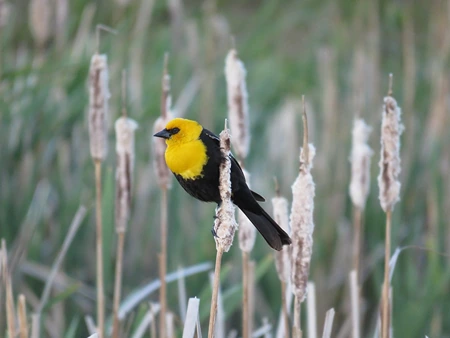
| Scientific Name | Xanthocephalus xanthocephalus |
| Size | 8.3-10.0 inches |
| Life Span | 11 years |
| Geographic Location | North America |
The second bird on this list of Black and Yellow Birds is the Yellow Headed Blackbird. As its name suggests, the most distinctive feature of the Yellow-headed Blackbird is its bright yellow head.
Only males have colorful plumage; females have a brownish-black body and a more muted coloring. The Yellow-headed Blackbird eats a range of things, such as seeds, insects, and tiny aquatic creatures.
3. Townsend Warbler

| Scientific Name | Setophaga townsendi |
| Size | 4.5-5.0 inches |
| Life Span | 9 years |
| Geographic Location | Western North America |
Named after John Kirk Townsend, an American naturalist, this species is known for its vibrant plumage, intricate patterns, and migratory behavior.
Townsend Warblers have a striking appearance with a yellow face and underparts, a black throat, and distinct black streaks on its sides.
Its back is covered in a combination of black, olive-green, and gray feathers, creating a stunning pattern that sets it apart from other warbler species.
These birds exhibit extraordinary migratory behavior, spending the summer months in the colder northern regions and wintering in the warmer southern parts.
4. Western Tanager
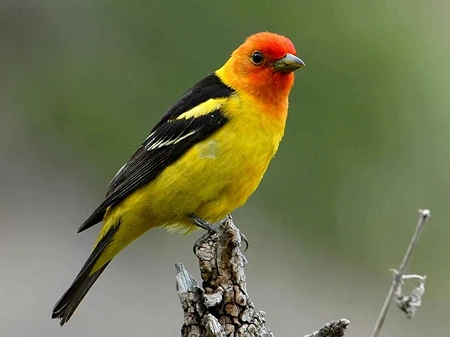
| Scientific Name | Piranga ludoviciana |
| Size | 6.3-7.5 inches |
| Life Span | 7 years |
| Geographic Location | Western North America |
Next up, on this list of Black and Yellow Birds, we have the Western Tanager. The male displays a stunning trichromatic pattern: a vivid yellow body, contrasting black wings and back, and a striking red-orange head.
This striking coloration makes it stand out against the green foliage of its woodland habitat. The male Western Tanager sings loudly and melodiously throughout the forest during the mating season.
While it primarily feeds on insects, including beetles, ants, caterpillars, and bees, it also consumes a wide range of fruits and berries.
5. Blackbirnian Warbler
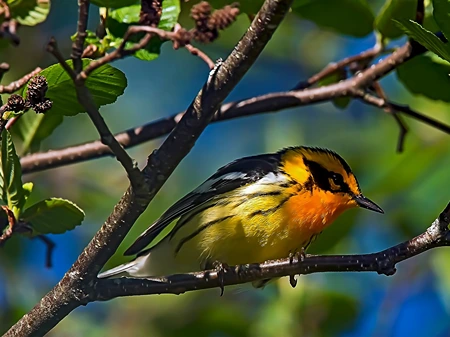
| Scientific Name | Setophaga fusca |
| Size | 4.3-5.0 inches |
| Life Span | 8 years |
| Geographic Location | Eastern North America |
Small and colorful, the Blackburnian Warbler enchants birdwatchers with its striking plumage and captivating vocals.
This warbler species, named after the English botanist Anna Blackburne, is distinguished by its orange neck, wings with black and white patterns, yellow belly, and affinity for mature coniferous and mixed forests.
It prefers higher altitudes because there are more good nesting locations and insect resources there.
The Blackburnian Warbler is known for its acrobatic foraging behavior, often seen hopping and flitting between branches and foliage in search of insects, spiders, and small arthropods.
6. Lesser Goldfinch

| Scientific Name | Spinus psaltria |
| Size | 9-12 centimeters |
| Life Span | 7 years |
| Geographic Location | Western North America |
The Lesser Goldfinch is a small songbird that belongs to the finch family. The males have bright yellow underparts and flanks that contrast with their black backs and crowns. The beaks of both sexes are small and conical, making them ideal for breaking seeds.
A large portion of the Lesser Goldfinch’s diet consists of seeds, with a preference for tiny seeds from plants including grasses, thistles, and sunflowers. Using their specialized beaks, they are skilled in removing seeds from plants.
7. Prothonotary Warbler
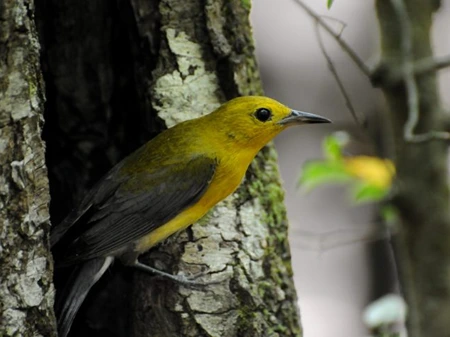
| Scientific Name | Protonotaria citrea |
| Size | 4.5- 5 inches |
| Life Span | up to 8 years |
| Geographic Location | Eastern North America |
Next up, on this list of Black and Yellow Birds, we have the Prothonotary Warbler, a Small and colorful bird enchants birdwatchers with its striking golden plumage and captivating voice.
It has a striking appearance with its bright golden-yellow plumage, which extends from its head down to its underparts. It has a bluish-gray to black back and wings, adding a subtle contrast to its vibrant yellow color.
They have a strong preference for nesting in tree cavities or man-made nest boxes near water bodies. Their bright plumage and lovely songs add a touch of beauty and charm to the wetland habitats they inhabit.
8. Black and Yellow Broadbill
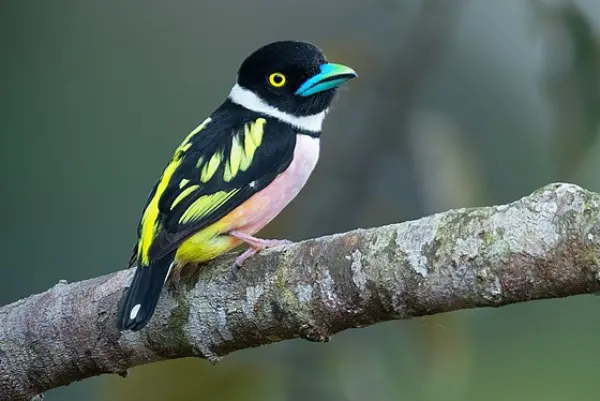
| Scientific Name | Eurylaimus ochromalus |
| Size | 5-5.9 inches |
| Life Span | up to 19 years |
| Geographic Location | Brunei, Indonesia, Malaysia, Myanmar |
The Black and Yellow Broadbill is the next bird on this list of Black and Yellow Birds. These birds have a black-and-yellow body with a yellow belly, a black head, and a white collar. They also have a pink chest.
For catching and consuming its favorite diet of insects, the broad, flat bill is excellently fitted. The main food sources for the black-and-yellow broadbill are insects, particularly orthopterans (grasshoppers, cicadas, etc.), mantises, and beetles.
The International Union for Conservation of Nature (IUCN) has designated the black-and-yellow broadbill as being near-threatened on the IUCN Red List.
9. Black-and-Yellow Silky-flycatcher
| Scientific Name | Phainoptila melanoxantha |
| Size | 18-25 centimeters |
| Life Span | not known |
| Geographic Location | Panama and Costa Rica |
The Black-and-Yellow Silky-flycatcher is a medium-sized songbird with a striking appearance. Its head, neck, back, and wings are covered in glossy black plumage, while its underparts are a bright and prominent yellow.
This bird is quite stunning to look at because of the contrast between its black and yellow feathers. The main components of the Black-and-Yellow Silky-flycatcher’s specialised diet are fruits and insects.
It forages high in the forest canopy, using its agile flight skills to capture flying insects and pluck fruits from tree branches.
10. Yellow-rumped Cacique
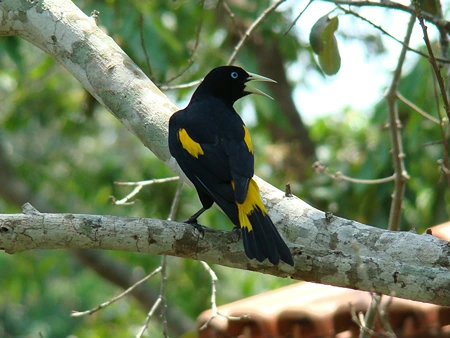
| Scientific Name | Cacicus cela |
| Size | 11 inches |
| Life Span | 7-16 years |
| Geographic Location | Northern South America |
Next up, on this list of Black and Yellow Birds, we have the Yellow-Rumped Cacique. As the name suggests, this bird has a characteristic yellow rump, and wing patches, while the rest of the body is black.
This species is highly social and is often seen in large colonies consisting of multiple breeding pairs.
A variety of foods, mostly fruits, nectar, and insects, make up the Yellow-rumped Cacique’s diet. This species is quite social and usually exists in huge colonies with several breeding couples.
11. Eastern Yellow Robin
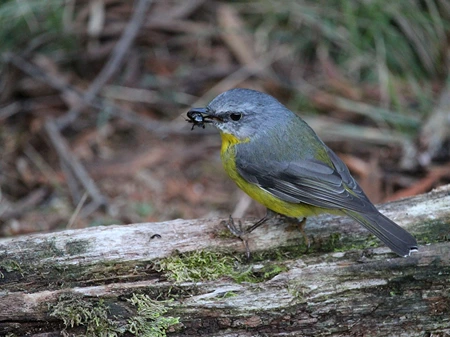
| Scientific Name | Eopsaltria australis |
| Size | 15-17 centimeters |
| Life Span | up to 14 years |
| Geographic Location | East and Southeast Australia |
The Eastern Yellow Robin is a robin of average size with yellow underparts and a greyish-black head and back.
The rump of southern birds is olive-yellow, whereas that of northern birds is brighter yellow. Its striking yellow coloring distinguishes it from other robins and adds a touch of sunshine to its surroundings.
The major components of the Eastern Yellow Robin’s diet are tiny invertebrates and insects. It hunts by leaping to the ground or pounces on animals from perches, utilizing its acute vision to identify feasible meals.
12. Canada Warbler
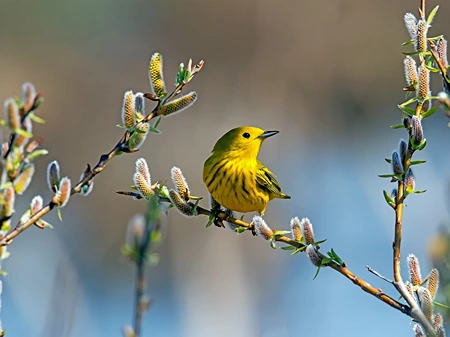
| Scientific Name | Cardellina canadensis |
| Size | 12 centimeters |
| Life Span | up to 8 years |
| Geographic Location | North, Central and South America |
The lovely Canada Warbler is a migratory species that breeds in the northern woodlands of North America and winters in Central and South America.
Both the male and female have brilliant yellow underparts and grayish-blue upperparts, giving them both a similar look.
The necklace of black streaks that adorns this bird’s yellow breast, giving it a unique and eye-catching appearance, is one of its identifying characteristics. The main components of the Canada Warbler’s diet are insects including beetles, caterpillars, and flies.
13. White bellied Canary
| Scientific Name |
Crithagra dorsostriata |
| Size | 11.5-13 centimeters |
| Life Span | 12 years |
| Geographic Location | Northeast Africa |
The next species on this list of Black and Yellow Birds is the White-Bellied Canary. Justifying its name, the bird displays a yellow head, chest, and throat that slowly transitions into its white belly.
The back and wings are olive-green while the wings and tail have black feathers. The IUCN currently lists the White-Bellied Canary as a species of Least Concern.
14. Great Tit
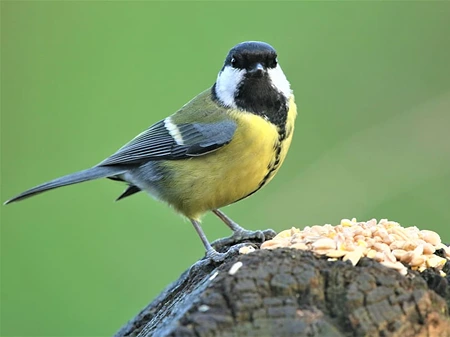
| Scientific Name | Parus major |
| Size | 12 centimeters |
| Life Span | up to 14 years |
| Geographic Location | Europe, Asia, North Africa |
The Great Tit has a black head, white cheeks, and a distinct black stripe running down the middle of its yellow chest and belly. The wings have white wing bars, and the upperparts are greenish-olive.
They also have a black pattern on their upper chest that resembles a bib. Great Tits can be found in a variety of habitats, including woodlands, parks, gardens, and urban areas.
15. American Goldfinch
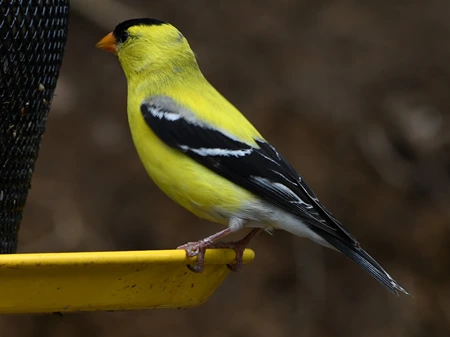
| Scientific Name | Spinus tristis |
| Size | 19-22 centimeters |
| Life Span | 11 years |
| Geographic Location | North America |
The males of American Goldfinches are a classic example of Black and Yellow Birds. During the mating season, the adult male has brilliant lemon-yellow plumage, a black forehead, and black wings with white wing bars.
In North America, open fields, meadows, grasslands, and forest borders are common habitats for these finches. The primary element of the American Goldfinch’s diet is seeds, particularly those from composite plants like thistles, dandelions, and sunflowers.
16. Evening Grosbeak

| Scientific Name | Coccothraustes vespertinus |
| Size | 18-23 centimeters |
| Life Span | 16 years |
| Geographic Location | North America |
The brilliant yellow body and forehead plumage, the black wings with white patches, and the huge, recognizable light greenish-yellow beaks of the males give them a remarkable appearance.
The food of the Evening Grosbeak is varied and mostly made up of seeds and fruits. They can eat many different types of seeds, including those from maple, ash, pine, and spruce trees, thanks to their strong beak that is made for rupturing tough shells.
17. Black-Faced Canary
| Scientific Name | Crithagra capistrata |
| Size | 11-12 centimeters |
| Life Span | 12 years |
| Geographic Location | Southern Africa |
The Black-faced Canary is a little bird with a distinctive black face mask that stretches from the forehead to the throat and a short, conical beak.
While the rest of its plumage varies according to the subspecies and individual, it typically consists of pale yellow or white underparts and a blend of yellow, olive-green, and brown tones on the upperpart.
These canaries are frequently seen in open forests, savannas, and grasslands. Most of the seeds in the Black-faced Canary’s diet are grass seeds and insects.
18. Magnolia Warbler
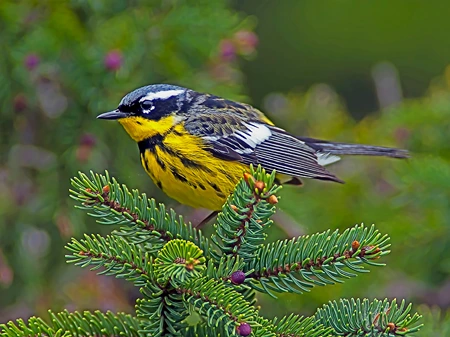
| Scientific Name | Setophaga magnolia |
| Size | 12 centimeters |
| Life Span | 6-7 years |
| Geographic Location | North and South America |
Next up, on this list of Black and White Birds, we have the Magnolia Warbler, named after the magnolia tree, although it does not have a specific association with that tree species.
Males have a black mask over their faces, a yellow neck, and brilliant yellow underparts with black streaks during the mating season. They have mostly olive-green back with a white wing patch and black tail feathers with white edges.
19. Black-backed Oriole
| Scientific Name | Icterus abeillei |
| Size | 22-24 centimeters |
| Life Span | 11 years |
| Geographic Location | Central America |
The next species of Black and Yellow Birds on this list is the Black Backed Oriole. The underparts of males are a vivid yellow color, which contrasts with a black head, neck, and back. The wings have yellow wing bands and are also black.
The habitats of Yellow-backed Orioles include tropical forests, woodland borders, plantations, and gardens. The Yellow-backed Oriole mostly consumes fruits, nectar, and insects in its diet.
20. Hooded Warbler
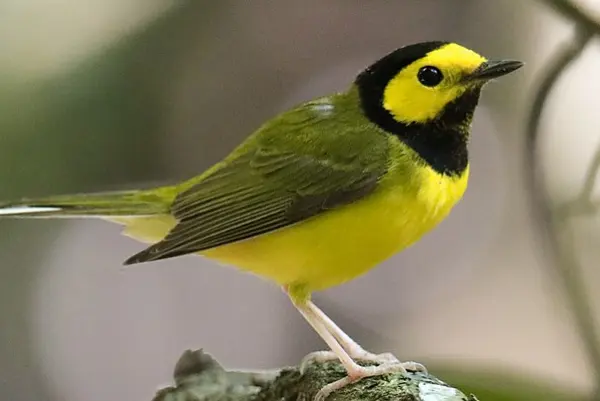
| Scientific Name | Setophaga citrina |
| Size | 12 centimeters |
| Life Span | 8 years |
| Geographic Location | North America |
The Hooded Warbler is a small migratory songbird, known for its distinctive black hood. The brilliant yellow underparts of the Hooded Warbler stand out vividly against the black hood that covers its head and upper breast.
They prefer habitats with dense understory, such as deciduous forests, woodland edges, and shrubby areas near streams or wetlands. The majority of the Hooded Warbler’s diet consists of tiny invertebrates like insects.
21. Keel Billed Toucan
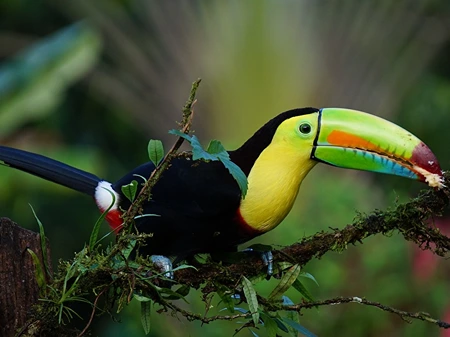
| Scientific Name | Ramphastos sulfuratus |
| Size | 42 to 55 centimeters |
| Life Span | 15-20 years |
| Geographic Location | Central and South America |
The Keel-billed Toucan is easily recognized by its large, multi-colored beak, which measures up to one-third of its length. The majority of the beak is green and yellow-orange, with a red tip and a black base.
The bird has a breast that is a brilliant yellow color and black body plumage. Keel-billed Toucans, found in Central America’s lowland and mountainous woods, typically eat fruits, especially figs, and occasionally eats tiny birds, berries, insects, eggs, and reptiles.
22. Yellow Throated Warbler
| Scientific Name | Setophaga dominica |
| Size | 13-14 centimeters |
| Life Span | 6 years |
| Geographic Location | eastern and southeastern parts of North America |
The Yellow-throated Warbler has a white belly, mostly grey upperparts, and a vibrant yellow breast and throat. Its sides and back are streaked with black.
The main diet for the Yellow-throated Warbler are insects and spiders, which it obtains from leaves and trees. In terms of conservation status, the Yellow-throated Warbler is now regarded as a species of least concern.
23. Yellow-Throated Toucan

| Scientific Name | Ramphastos ambiguus |
| Size | 55-63 centimeters |
| Life Span | 15-20 years |
| Geographic Location | Native to the rain forests of Central and South America. |
The Yellow-throated Toucan’s vibrant plumage, large bill, and lively behavior make it a charismatic species of the tropical rainforests it inhabits.
It has a distinctive, large, and brightly colored bill, which is mainly yellow, but with a dark chestnut or reddish-brown patch near the base, and covers almost half of the bill.
Feeding mostly on fruit, the Yellow-throated Toucan consumes a wide range of tropical fruits like figs, palm fruits, and berries. Being an opportunistic feeder, they will also eat insects, lizards, and small vertebrates.
24. Golden Collared Manakin
| Scientific Name | Manacus vitellinus |
| Size | 10-12 centimeters |
| Life Span | 6-7 years |
| Geographic Location | Panama and Colombia |
The second last species in this list of Black and Yellow Birds is the Golden Collared Manakin, belonging to the family Pipridae. The throat and upper breasts of males are encircled with a brilliant golden collar, giving them a distinctive look.
The primary components of the Golden-collared Manakin’s diet are fruits and insects. They actively forage for tiny fruits, berries, and arthropods in the understory layer.
The International Union for Conservation of Nature (IUCN) lists the Golden-collared Manakin as a species of least concern since its population is relatively stable.
25. Scott’s Oriole
| Scientific Name | Scott’s Oriole |
| Size | 23 centimeters |
| Life Span | 6 years |
| Geographic Location | Southwestern United States |
The Scott’s Oriole has a unique plumage, with male adults displaying bright yellow underparts in contrast to their black heads and necks. Additionally, they have prominent white wing patches and tail feather margins.
The Scott’s Oriole consumes a variety of foods, such as fruit, nectar, insects, and spiders. They are known to stop by flowers to drink nectar, particularly those of the agave and ocotillo families. They also eat tiny invertebrates that they find amid the plants.
Now, we come to the end of our today article, 25 Black and white birds. Hope you have liked it. Stay tuned for many such interesting articles in the future.
References:
- Allaboutbirds.org- Townsend’s Warbler
- Animalia.bio – Black and Yellow Broadbill
- Allaboutbirds.org- Canada Warbler
- Australian Museum – Eastern Yellow Robin
- A-z Animals- Keel Billed Toucan
Also Read:

A zoology student turned writer. Nature has always been a magnet to me, and to unearth some of its secrets through my articles is my prime intention. If not engaging myself with nature and anime content, you can always find me going through some Bengali classics or filling the air with some soulful Tabla beats. An artist, trying to throw some colors to my blank canvas of life.
